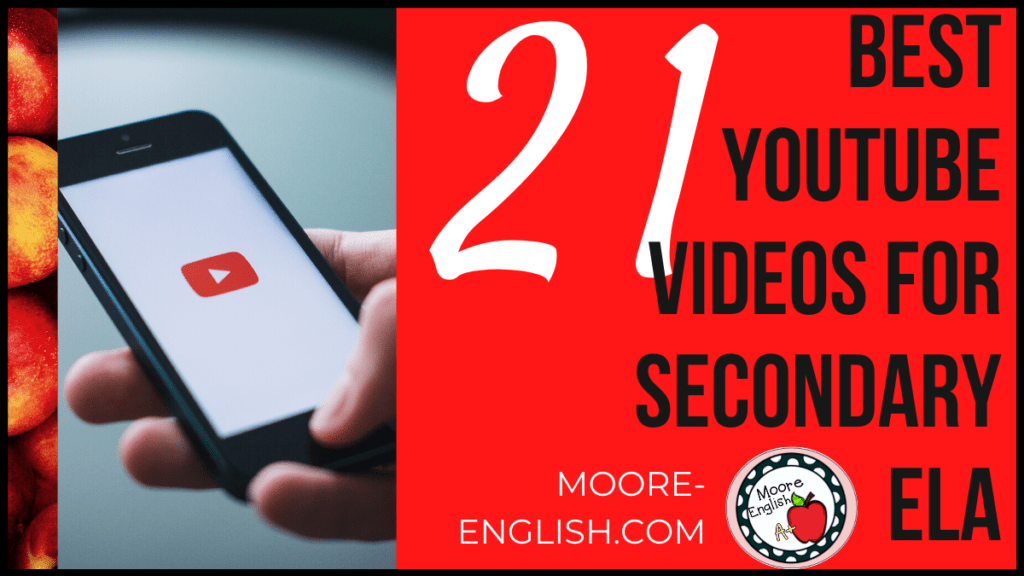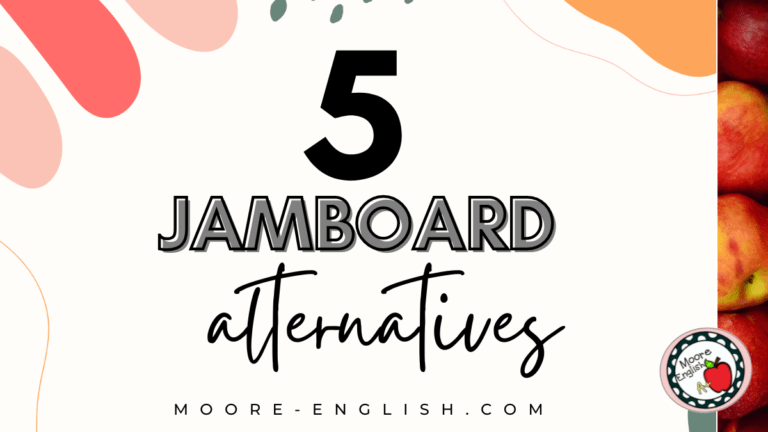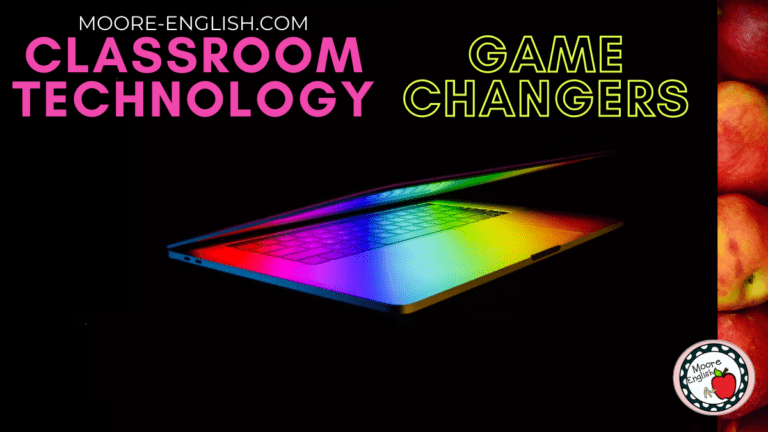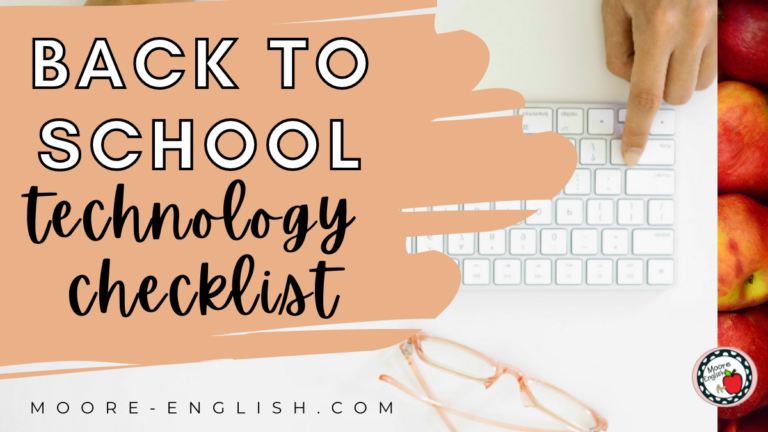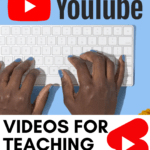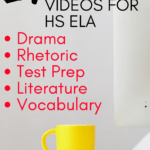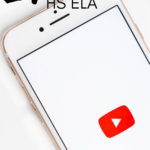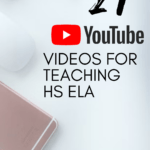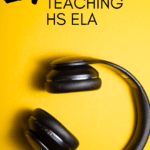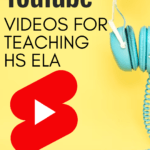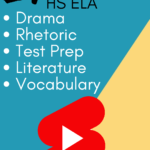My district started school last week. And one of my favorite back-to-school activities is watching and discussing How and Why We Read from CrashCourse. After watching the video and completing this free listening guide, my students discuss the definition of “literature” and the importance of reading. This serves as an opportunity for students to establish discussion norms and also gives me early insight into my students’ ability to listen, react, and respond. But this isn’t the only YouTube video I show in class. So I put together a list of my 10 favorite YouTube videos for secondary ELA.
This post this post may contain affiliate links. Please read the Terms of Use.
Videos for Vocabulary
My first few years of teaching, I was satisfied when students told me they determined the meaning of an unknown word by using “context clues.” After a few years, though, I began to realize that my students could not point to any specific context clues. Instead, they had just learned that if they said “context clues,” teachers would nod and move on. Frustrated, I began looking for tools to help my students identify, name, and use specific context clues.
In that search, I found a Study.com video How to Use Context Clues to Determine the Meaning of Words. This video takes students through specific context-clues strategies, including definition/restatement, synonym/antonym, example, and substitution. While we watch this video, students make a quick set of foldable notes, and then we make a large anchor chart that we reference frequently. This is an invaluable tool for setting my students up to work with context clues from To Kill a Mockingbird, Things Fall Apart, or any of Shakespeare’s work.
Videos for Grammar
TED-Ed has excellent videos for a variety of subjects. But my two favorites are Comma Story by Terisa Folaron and How to Use a Semicolon by Emma Bryce. I use Comma Story to introduce the difference between coordinating and subordinate conjunctions. First, we make a list of what we already know about conjunctions. Then, we watch the video. Finally, we end by applying comma rules to subordinate clauses. It’s a video we refer back to all year long! In preparation for using Comma Story this year, I made a listening guide to help my students follow along with the film and internalize its lessons.
While I’ve been using Comma Story for a few years now, I only recently started showing How to Use a Semicolon. In particular, this video does a good job helping students understand how to create and punctuate complex lists. For my older students, this is a good video to use when we’re studying syntax.
Another favorite from Ted-ed is Christopher Warner’s set of videos about verbal, situational, and dramatic irony.
Videos for Teaching Literature
As my students read The Great Gatsby, we often watch CrashCourse Literature. These videos can be used in a variety of ways, and each one has its own particular strengths. For example, the Emily Dickinson video is a great introduction to her work and even guides students all the way through one of her poems. Watching this video is often how I introduce her work.
However, the Pride and Prejudice videos are better understood later in the reading of the novel. So my students will watch these videos toward the end of our reading or even as test prep. Sometimes I also supplement the literature videos with other videos from the CrashCourse catalogue.
For example, I often pair the CrashCourse History Imperialism video with our study of Things Fall Apart or the Great Depression video with To Kill a Mockingbird.
Over the years, though, my students have told me that sometimes the videos seem to go too quickly. So I’ve made an entire set of listening guides for every episode of Crash Course Literature. As we watch an episode, my students fill out their listening guide. Then, they talk with their neighbors in an effort to fill in any blanks. Finally, we come back together as a class and discuss how our reading of the book has evolved after watching the clips.
Another video I like to watch when reading literature is Flocabulary’s Five Things (Story Elements). I’ve used this video in two ways. With younger students, it can be a good introduction to story elements. For my older students, this video is more of a review. Several times I’ve shown the video to students only to have them begin singing because they watched it frequently in middle school!
Finally, the Ted-ed video What is McCarthyism? And How did it Happen? is a great tool for setting up historical context for The Crucible.
Videos for Teaching Shakespeare
One of the most challenging Common Core standards to get right is 9-10.7/11-12.7, which deals with analyzing multiple versions of a work. A lot of teachers think it’s enough to simply read the novel and watch the movie. But there are better ways to approach this standard.
For Shakespeare’s Julius Caesar, showing key scenes from the Royal Shakespeare Company’s 2012 production is the way to go. For one, I don’t show every scene. Instead, after we read a key scene, I show a clip from the film. Then we discuss the director’s decisions, staging choices, and the differences between versions.
In particular, the early scene in which Cassius tries to convince Brutus to join the conspiracy is worth a watch. The scene takes place in the men’s room. And Cassius’ soliloquy happens in front of a mirror. The parallel scenes between Portia/Brutus and Calpurnia/Caesar are also worth a watch because of the director’s use of blocking and staging to show the difference between these two relationships. Portia and Brutus stand very close while the distance between Calpurnia and Caesar grows.
However, my absolute favorite piece to show with Julius Caesar is the short film I, Cinna, which retells the entire plot from the poet’s point of view. Talk about a different interpretation of events!
For Shakespeare’s Scottish play, the Flocabulary Macbeth rap is absolutely worth a watch and so is TED-Ed’s Why Should You Read Macbeth? However, neither of these videos will hit 9-10.7/11-12.7. But this video will! Clicking this link will take you to a 15-minute video (not made by me) that features the famous opening scene as it’s presented in five different films. In particular, this is a great way to discuss mood. How does each director build mood? And how are the moods different?
Videos for Teaching Rhetoric
Since we’ve been discussing Julius Caesar, we should also discuss rhetoric, which I teach through Shakespeare’s play. To introduce rhetoric, I show TED-Ed’s How to Use Rhetoric to Get What You Want. After watching the video, we make the rhetoric anchor chart I discussed last week. Then, we begin applying our new-found knowledge to television commercials. My favorite school-appropriate and rhetoric-heavy commercials are included in this playlist. I show these commercials in class. And we play/pause each commercial as we discuss the director’s rhetorical choices, including script writing and music choices. Finally, my students apply their rhetorical skills to their own classroom sermons.
Videos for Test Prep
Lots of these videos are great test prep. The grammar videos are good ACT English review. The CrashCourse videos are good watching for classroom unit assessments and for the AP Literature exam. Right before my state’s standardized testing, I always have my students watch Flocabulary’s Test-Taking Vocabulary video. It’s cheesy, but it provides a good review of common test-taking words.
A last cautionary note: none of these videos are teaching replacements. Each one can be a complement to an existing lesson. But none of them can replace you. What recommendations do you have for the ELA classroom? Which videos did I overlook? Let us know in the comments!



